 Back to selection
Back to selection
Pieces of Eight: New Directors/New Films (I)
 Of Horses and Men
Of Horses and Men Spring is a always a godsend, especially so after a harsh winter. For discerning cinephiles, it marks an end and a beginning. The exhausting awards season is over. It is followed in New York by a celebratory spring cleaning, a shift in priorities to some of the finest emerging directors from all over the world in the prestigious and prophetic New Directors/New Films, now in its 43rd edition (March 19-30). Not only do the principal artistic creators get their due, but, unlike the U.S.-centric January-to-March hyperamas, the pool of pictures is fiercely international.
How does ND/NF’s focus on the filmmaker compare to the Golden Globes and the Oscars? The primary bait for these audience magnets: best actor and actress, best supporting actor and actress, and celebrity gowns and what, if anything, is supporting them. Best Feature may be the final award given, but the moment is anticlimactic. Of the so-called main categories, Best Director ranks on the low end: it tends to be a consolation prize for the person whose film does not win Best Picture. Frankly, neither Dolby Theater nor home audiences seem to get too excited about it.
New Directors/New Films: The name alone highlights budding auteurs and their early efforts. These are first and second features, formative barometric pictures that leave footprints whether the filmmakers continue to make signature works or end up working solely on watered-down Hollywood projects or vapid Europuddings. This coproduction of the Museum of Modern Art and the Film Society of Lincoln Center, two rather formidable institutions, dims its own wattage for each of a selection’s two screenings, the better to illuminate the film and the vision behind it.
This is part one of two articles (the second appears next week). It covers the first half of the 27 features. I can glibly quantify my assertion that this year’s crop is exceptionally good, because I particularly recommend eight in this portion of the festival, several more than I have in the past. They are listed below, in no particular order (unseen: A Girl Walks Home Alone at Night). A quick overview of the eight: geographically, three are set in Eastern Europe, two in Western Europe, one each in Africa, the U.S., and Latin America; and the recurrences that have struck me the most are dark lyricism, minimalism, and nonexistent, or at best unconsummated, sexual activity.
Most of the stars are unconventional, a far cry from those in the Golden Globe- and Oscar-nominated pictures. You won’t see gratuitous close-ups of stunning actresses or medium shots of beefy actors. No, the stars are not glamorous, often nonprofessional, i.e., credible. In several titles, they are inanimate. This may be the earth mother of all clichés, but nature assumes a featured role — in various ways, mind you, but it’s a cast member all the same.
Of Horses and Men, Benedikt Erlingsson, Iceland/Germany
The truth is in the eyes. Horses and men are alike in fundamental ways, according to Erlingsson. He backs up his thesis not only with four stories about intense relationships between man and horse, but with an old formal technique, the subjective POV shot. Here, though, just before each tale begins is a zoom into close-up of a large eyeball — the eyeball of an Icelandic horse, one of the small, genetically pure breed that is a justifiable source of national pride, nowhere more so than in the gorgeous volcanic northern countryside.
In this outstanding, genre-defying film, everything fits together — except when it doesn’t. Bergsteinn Borgulfsson’s cinematography captures the grace of groups of exquisite riderless horses as well as the harmony of man and beast, galloping against a backdrop of large white clouds, blue sky, and downs that abut the sea. David Thor Johnsson’s music, bouncy percussion and accordion that create a sound akin to Scottish pipes, is an ideal grounding accompaniment. In typical Icelandic fashion, irony and dry humor abound. In context, several funeral scenes are giggle-inducing.
In the one tale which overlaps the others, cocky middle-aged dandy Kolbeinn (Invgcar E. Sigurdsson, top photo, right) rides his beautiful white mare to the home of Solveig (Charlotte Boving, top photo, left), owner of a penned-in dark stallion. The couple follows proper etiquette; the horses do not. Custom demands castration. During the fall roundup, Kolbeinn and Solveig find themselves alone in a field. Double standard?
A second story involves the humiliation of another blowhard, a young foreign womanizer. Lost and near frozen in a snowstorm, he must find warmth with the involuntary aid of the horse he has been kicking. In the other two tales, the animals are more witnesses to the havoc wreaked by their reckless masters while going up against the sea and cliffs, respectively.

Stop the Pounding Heart, Roberto Minervini, Belgium/Italy/U.S.
In this poignant, handheld hybrid of documentary and fiction, how one treats an animal is a telling character trait. The 14-year-old leads, Sara Carlson and Colby Trichell, live in an open, leafy rural patch of East Texas, where a small creek acts as divider between their families’ properties. Each has multiple animals in their lives. Sara, whose strict, back-to-the-land Christian parents run a goat farm that produces milk and cheese to sell at local farmers’ markets, is gentle with them, gives them names, and lets the little ones suck on her fingers. Colby, who is already doing the rodeo circuit, views the bulls he raises and rides as rough, wild beasts to be mastered, not loved.
Sara is blossoming into adulthood and all that that involves in this third in Minervini’s Texas Trilogy. She is beginning to feel a prisoner of the religion she was born into, unlike her parents, who grew up outside. Their fundamentalist brand of Christianity calls for an extremely literal interpretation of the Bible and a Mennonite-like rejection of modern technology. Sara’s warm but dogmatic mother, Leanne, cannot help but notice her and Colby’s mutual attraction. She has taught her daughter that she should serve one man as a helpmate. Will this potential rebel be able to stop the pounding heart? This is the central conflict of the film, unhurried but richly rewarding.
Colby is also a Christian, but more in the vein of group prayer before a rodeo and obligatory Bible reading. His priorities are less God and Jesus than barbecue, beer, and secular gals. There is little to read in him, but it’s clear he is enamored of two things: chatting with Sara and mounting a bucking bull. (Interesting that she refuses to try sitting on the mechanical one he has built.)
Sara, however, has depth; she is pensive. As the oldest of 10 children, she takes on responsibilities and has almost a peer relationship with Leanne. The pressure on her now is enormous. Leanne is rather insidious in her self-assured delivery of dogma, even prejudiced. She home-schools her children in case they should veer away. Yet oddly, the film is packed with love, just not the kind we are used to in movies or in life.
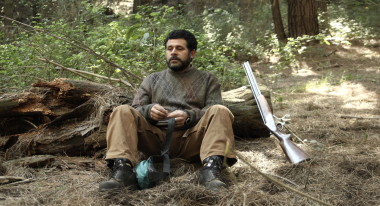
To Kill a Man, Alejandro Fernandez Almendras, Chile/France
This tightly structured gem follows two cases of revenge. One involves a lowlife drug dealer from the projects, Kalule (Daniel Antivilo), who shoots a teenaged boy, Jorgito, who is trying to retrieve the diabetes medication stolen at the community soccer field from his father, Jorge (Daniel Candia, the film’s protagonist in an outstanding, underplayed performance), a forest ranger on the way to his house in the working-class neighborhood nearby.
The perp emerges from a mere 18 months in prison vowing to harass Jorgito, his sister, Jorge, and his wife in increasingly dangerous ways. A class-conscious judicial system fails the frightened family: The best it can do is to serve a weak restraining order. The inaction takes a toll: Jorge and his wife, Marta, divorce. Jorge begins living at the ranger station.
The other case of revenge is the one associated with the title. After Kalule sexually molests his teenaged daughter, the otherwise passive Jorge returns to the barrio, rifle in hand. Operating methodically, he locks the thug in the back of his truck and drives to his work site.
Almendras details the minutiae of murder, such as post-killing complications of disposal, deflecting suspicion from police, family, and friends, and checking availability of a support system in advance. He keeps off-screen not only the most emotionally affecting events — like what has led up to and follows the divorce as well as what appears to be the family’s rejection of Jorge — but also the increasing number of scenes of blood and decay.
Inti Briones’ widescreen photography is crisp in limited, pared-down locations. Much of the film, especially the city scenes, is shot at night, so the impeccable lighting makes even the poorest nabes appear inviting. Sequences filmed in the forest preserve where Jorge labors and later lives are splendid, rocky cliffs beyond the tall fir trees leading way way down into a protected chunk of the deep blue Pacific.
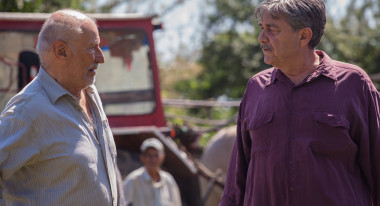
The Japanese Dog, Tudor Cristian Jurgiu, Romania
At first the center of this moving film from Romanian director Jurgiu is the elderly Costache (Victor Rebengiuc, perfect), a tough villager who has just lost his wife and home to devastating floods and now lives alone in various buildings granted by the mayor. Once his estranged son, Ticu (Serban Pavlu), daughter-in-law Hiroko (Kana Hashimoto), and adorable grandson Koji (Toma Hashimoto) arrive unannounced from Japan, the movie turns into a subdued but rich family melodrama that you might call “Ozu without tatami mats.” It is, however, never imitative.
Surely the fact that Ticu left for Japan, then got a job and decided to stay on, is not a function of chance in screenwriting. (The father-son disconnect began after Costache and his late wife had been forced to take care of the heartbroken fiancée he left behind.) It not only highlights the Ozu influence, but also makes sense of the film’s strong emphasis on nature as a presence and force in the villagers’ lives, a worldview much more Japanese than Romanian. The film opens with a long shot of the locals standing in their rain boots picking through what little remains of their possessions. After that initial cruel act, nature is once again a benign but entrancing presence: rolling hills, verdant fields, and strong trees, a setting for which the firm, stubborn Costache appears well suited.
Water has special significance. We know its destructive side. The old stucco wall and built-in bench in town center has a spout where Costache fills empty jugs everyday. It is there late one night that the most dramatic encounter in the film takes place, one between an inebriated old man and his bewildered son.

Mouton, Gilles Deroo & Marianne Pistone, France
D.P. Eric Alirol shoots most of this brilliant, deceptively complex film in documentary style, which is fitting for the theme of randomness that runs through it. Part One centers almost exclusively on Mouton, a 17-year-old boy who is granted emancipation from his alcoholic mother in the opening scene and immediately moves to the Norman coastal town of Courseulles-sur-Mer, where he gets room, board, and a salary training as a chef’s apprentice in a middle-class seaside restaurant. He is happy to be independent and enjoys his banal routine, which for us is comparable to non-sequiturs in a loner’s daily journal.
Toward the end of the first section, Mouton suffers a sudden tragic assault at a festive party for restaurant employees. Part Two begins with Mouton having moved away. Surprisingly the co-directors shift the interest to several of his petit-bourgeois work friends, who were merely supporting players in Part One. It appears that his severe injury affected them all, but you can’t be sure: By now it’s off-season, a melancholic period in oceanside resorts.
We find now that the randomness and documentary style are impure. Written text predicts time frames and events, as if predestination is at play. Chance versus free will, Bazin versus Dreyer. Several scenes are clearly staged — twin brothers in bed with a hooker, for example — and embellished with lengthy fades. Intention supplants action: A character means to write the recovering Mouton, but doesn’t find the time. This is life as it is lived more than as it can be dramatized.
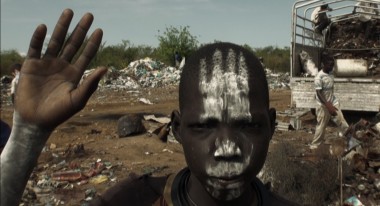
We Come as Friends, Hubert Sauper, France/Austria
Sauper wanted freer access than he was afforded in Darwin’s Nightmare, so he designed and built his own lightweight plane, Sputnik, and flew it from France to Africa. He went wherever he wanted but still stumbled upon the unexpected. Ironically, three years into the six-year production, the area he was exploring and exposing became by referendum the world’s newest country, South Sudan.
The mostly Christian population of the southern portion of what had been Sudan gained their independence from the primarily Muslim Arab majority farther north, from which came the militias under the guidance of indicted war criminal Omar al-Bashir that inflicted endless horrors upon the southerners. What Sauper reveals can be summed up by the example of a tribal leader who discovers he has been ripped off in the sale of land to a profit-seeking foreign company, even though he had fought for 21 years to gain freedom and independence. Colonialism has reappeared with a new face: capitalism.
He shows us the tenuous ties that corporations investing in South Sudan have with humanitarian organizations. Chinese companies take out 300,000 barrels of oil every day, no matter that they displace many locals, some of whom end up living on burial grounds, pollute the water of those who remain, and leave huge trash heaps unattended. He shoots the interior of a summit of western investors in a modern hotel who can hardly mask their ubercapitalist motivations. The USAID honcho looks ridiculous and talks gibberish.
Sauper and Barney Broomfield share cinematography duties. Given the makeshift situations they frequently find themselves in, the film looks wonderful. Once again, editor Denise Vindevogel stitches into a meaningful whole what might have appeared to be unrelated situations, especially because Sauper wants the pieces to speak for themselves, leaving out any trace of didacticism from his own voiceover. She gives the finished film a splendid rhythm that works smoothly with Malia’s jazz vocals.
Sputnik takes him to American evangelicals who try to impose their values on those who live according to custom. It is God Loves Uganda all over again, except that this group wants to build the new Texas. Clothing is a major issue. Without a specific uniform, children can not enter certain schools; their traditional garb has no currency. Sauper films a fantastic indigenous dance ceremony that is lively and colorful until you realize that all the women are wearing old-fashioned ivory-white bras.
Some sequences show the modernity associated with hi-tech development: the oil facility, a few luxury hotels. At the end, Sauper adds footage shot on a cell phone by a South Sudanese soldier: ground combat just as before. Nothing has changed for the people who actually live there.
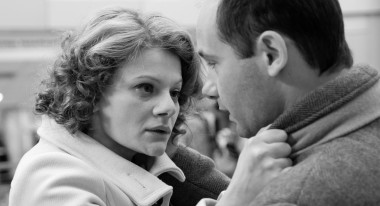
Quod Erat Demonstrandum, Andrei Gruzsniczki, Romania
The resemblance to Bujalski’s Computer Chess stops at period and props. Gruzsniczki’s film is hardly a humorous replay of the early computer days in the U.S.; it’s a hard look at the nightmare of the mid-’80s in Ceaucescu’s Romania, set in the academic math milieu after computers had become an integral part of the process. Vivi Dragan Vasile’s photography is a bleak black-and-white that pulls you right into the period, as if the film were made at that time. The sets, costumes, even haircuts are just right without being overdone. All of the technical items — computers, tape recorders, telephones — are made to order.
Scarcity is so prevalent that betraying loved ones for goods and perks is the norm. Sorin (Sorin Leoveanu), an unsung mathematical genius (he has never been invited to a conference), is under surveillance for smuggling out a manuscript for foreign publication. Never mind that it was refused at home.
Much of the drama revolves around him and his integrity, especially after he proves a major new theorem that he wants to smuggle out. This time, however, the situation is different from before: Nasty Alecu (Florin Piersic Jr.) of the Secret Police is on to him and needs the arrest for his own promotion; and Sorin requires an accomplice to take it. The only possibility is his old friend and colleague Elena (Ofelia Popii), a computer programmer and wife of a pal who has already left permanently for France and expects her and their young son to join him. The shameless Alecu observes her closely.
Sorin may have tackled math’s complex Fourier series, but can he outwit a vile glorified policeman? Can Elena resist the pressure Alecu exerts on her using her sick old father as leverage? On a more intimate note, can Sorin and Elena repress the attraction that has been slowly building up and threatening their personal and professional lives? Meanwhile, like many decent folks who lived during that era, Elena and Sorin attend dinners, receptions, and baptisms with colleagues they know to be treacherous. It was the way people had to live.
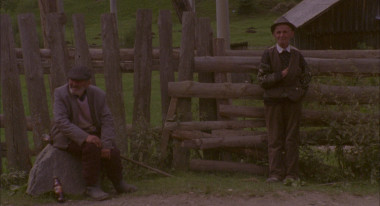
The Vanquishing of the Witch Baba Yaga, Jessica Oreck, U.S.
Running the length of this labor-intensive doc about man’s late-developing historical estrangement from nature are excellent hand-painted animated panels depicting a composite Slavic fairy tale about displaced tween siblings Ivan and Alona who have, out of desperation, taken refuge in a forest they had learned to fear as small children.
Residing there is the evil witch Baba Yaga, whose house is built on chicken legs and who eats children. After she captures Ivan and Alona and gives them three impossible tasks, the punishment for not finishing them being roasted for her dinner, they outwit her and overcome their fear, just in time to gain their freedom and bring in to the now-sanctified woods the victims of evil soldiers preying upon their village.
Bloody warfare and ethnic conflict in the 20th century necessitated a revaluation of the myth. The animated tale illustrates the process of subduing the ingrained phobia, so that people could take refuge in the woods.
Sections of the fairy tale are cross cut with contemporary shots filmed in five Eastern European countries by d.p. Sean Price Williams that bear some visual or functional relationship. Most are impressionistic and fast-moving scenes from nature, traditional villages, or restless cities. Among the other media and techniques Oreck uses are contemporary 16mm and archival footage, heady voiceover, and an eclectic music track that includes abstract melodies and regional folk songs. The Vanquishing is a zinging mix of naturalism and edge.
The film is about much more than a fairy tale about Baba Yaga. The narrator explains how memory enables fairy tales to develop, to become stories retold. In the same way, we internalize customs and rituals that have changed over time. We become afraid of whatever is outside our comfort zone. We construct unfriendly protective barriers like fences and bunkers. The narrator makes accessible a lot of complex information, such as how man became detached from the land, and how he abandoned the cycles of nature in favor of hammering time flat. It’s deep, and deeply beautiful.
